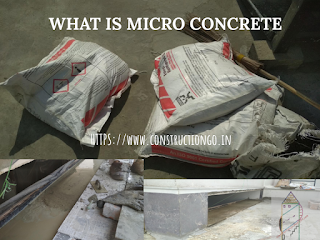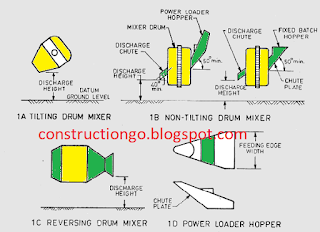What is Micro Concrete?
Micro concrete is the concrete that has the property of free flow, no shrinkage, and bit flexibility. These are special types of cement bags containing fine aggregates and fiber material for proper bonding.
Where we should use Micro Concrete? What is the purpose of micro concrete?
The main use of micro concrete is for repair work. Also where it is difficult to pour concrete (nonreachable area). Due to the properties of no shrinkage and free flow, it is easy to use for repair areas as it reaches gaps and also does not shrink.
How to use Micro Concrete?
Micro concrete is very simple to use. If the thickness is less than 100 mm, we have to just add 4 liters of water to one bag of micro concrete ( 25 kg each ). And if it's more than 100 mm then we have to add 10 mm aggregates ( clean ). Mixing should be proper if in the mixer then it should rotate for 30 rounds and if manually then extra care should be taken so that no lumps are formed.
Do we have to do Curing of Micro concrete?
Yes. We have to do the Curing of Micro Concrete, though it has the property of being nonshrinkable, we have to do curing for a minimum of 7 Days.
What Precautions are to be taken while using Micro Concrete?
While using micro concrete we have to see that water should not be exceeded more than 4 liters, mixing should be proper, Person using micro concrete should be covered with gloves, eyes wear, and a mask. Micro concrete can damage eyes and lungs, extra care should be taken while using Micro Concrete.
Mix Proportion (By Weight) 1 : 1.99 : 2.43 Water Cement Ratio 0.32 Cementatious Content 425 kg / cu.m Cement Content 319 kg / cu.m Flyash Content 106 kg / cu.m Natural Sand Content 845 kg / cu.m Coarse Aggregates 31.5 mm 723 Kg / cu.m Coarse Aggregates 10 mm 310 Kg / cu.m Admixture Auramix 300 of Fosroc Chemicals 4.2 Kg / cu.m Water Content (W.rt.WC Ratio) 136.0 Lit / cu.m Water Absorption of CA @ 0.9 % 9.2 Lit / cu.m Water Absorption of FA @ 1.2 % 10.1 Lit / cu.m
The above water content is recommended considering dry aggregates; as such correction for absorption is made. In order to maintain workability, proportionate adjustment as above (water absorption), in the quantity of water shall be made, if the aggregates received are wet. The grading of the aggregates shall be checked regularly & should match the grading of aggregate received in the laboratory as this may have an effect on the strength & another characteristic of the concrete. The admixture used shall be, Auramix 300 of Fosroc Chemicals. The quality of the admixture shall be checked regularly. If required dosage shall be adjusted as per site condition and workability requirement, keeping the same water-cement ratio as recommended above. The density calculated for the above-recommended mix is based on a laboratory trial. If there is any variation in material gradation, proportions of ingredients shall be adjusted by measuring the actual density at the site, while maintaining the same cement content. The quality of fly ash shall be confirmed before use. The Blain’s air-specific surface shall not be less than 320 sq.m/kg.
R.C.C.:- Cement concrete is the most widely used man-made construction material. It is popular as a construction material because it is cheap, durable, and has insulation and thermal property as well as the ability to be molded into the desired shape.
Cement, sand, coarse aggregate, and water are the raw materials required for manufacturing concrete. They are easily available. For tensile strength, steel is used in cement concrete. It is then termed the Reinforced Cement Concrete (R.C.C.). This material is not likely to be replaced easily by alternate building material.
Quality control in concrete construction.
***
***
checks the problems of the variability of ingredients and ensures proper workmanship for batching, and mixing. placing. compaction and curing of the concrete. The main objective of quality control is to guarantee high quality, in accordance with the assumptions made in the design. In this chapter, we will look at the quality aspects of building construction, workmanship, and the checks required for maintaining the quality of workmanship. Tools required for concreting are almost the same as masonry work.
BASIC COMPONENT (RAW) MATERIAL SPECIFICATION AND ACCEPTANCE CRITERIA:- For preparing concrete, the following parent materials should be used.
(1) CEMENT: Ordinary Portland cement is the most widely used cement for making concrete. 43 grade and 53 grade of cement can also be used. The following field test should be carried out before using it.
Field test for cement :
- check the weight of the cement bag with a weight balance. the weight of the bags should not vary more than 1.5 % of the standard weight of the cement bags which is 50 KG.
- Ensure that the original packing of the company is intact.
- Ensure on the bag, that the company name, date of packing, and grade are mentioned.
- check the date to ensure that cement is not out of date, it should be always of the same month.
- check if there are no lumps in the cement bags.
- The cement should be cool in temperature.
- The cement particles should float on water for some time.
- 50 mm x 50 mm x 50 mm cubes of cement paste should be kept in water. after 24 hours, the edges of the cubes should remain sharp.












0 Comments
Please click on follower button